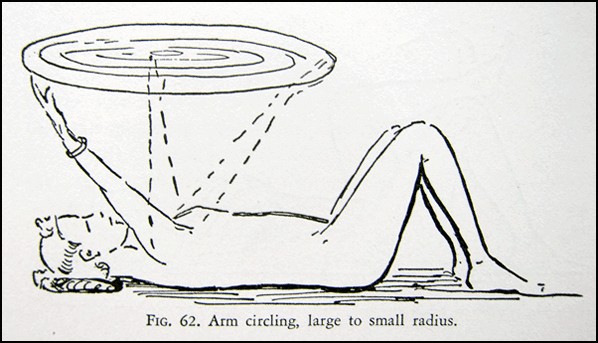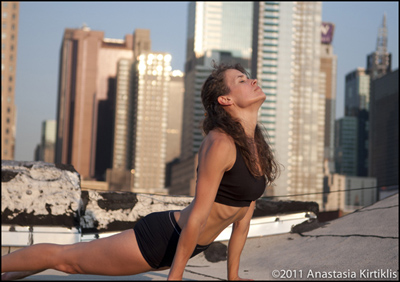stretching, science, & the wisdom of ‘boring’ yoga asana sequencing

 In the last few years, it’s come to light that static stretching isn’t a great thing before activities requiring muscle power. Most recently the New York Times reported researchers have discovered stretching is bad. The article mentions only once that static stretching, as opposed to dynamic stretching, is problematic. The rest of the article states time and again that stretching is bad. A skimmer might well come away with the idea she should avoid all stretching at all times. But static stretching is only problematic before you weight lift or row or do some other arduous activity. What’s with the dodgy reporting, NYT?
In the last few years, it’s come to light that static stretching isn’t a great thing before activities requiring muscle power. Most recently the New York Times reported researchers have discovered stretching is bad. The article mentions only once that static stretching, as opposed to dynamic stretching, is problematic. The rest of the article states time and again that stretching is bad. A skimmer might well come away with the idea she should avoid all stretching at all times. But static stretching is only problematic before you weight lift or row or do some other arduous activity. What’s with the dodgy reporting, NYT?
Static stretching involves holding the muscles in a stretch for a long time. Dynamic stretching stretches the muscles while moving, e.g. butt kicks, leg lifts, walking lunges, and these dynamic toe touches at right. Or, Surya Namaskara, sun salutations.
When I first read this a few years ago (my masters is in health, so I try to keep up), I couldn’t help but observe this is exactly what we do in ashtanga, and exactly how I sequence my vinyasa classes. Kind of like the research that revealed exercise before breakfast is better for weight loss. Yogis knew that. While I’m all for well-conducted and well-reported research (difficult and thus rare when involving human behavior), I strongly reject the notion that empirical evidence is the only valuable knowledge. Or as Jon Kabat-Zinn (PhD in MCB from MIT) said, “Oh my god. There is an entirely different way of knowing. Why didn’t they tell us this in kindergarten? An entirely different way of knowing.” In other words, something doesn’t have to be “science” to be valuable. But I’ll rant about that and the “Science of Yoga/Yoga Science” meme another day.
Occasionally I hear students complain about boring sequencing. I try to avoid condescending comments like, “If you are bored in your yoga practice, you are missing the point. You will never know anything about your mind until it has been bored.” If you aren’t doing yoga to learn about your mind, that’s fine. Either deal with the boredom anyway or find another teacher who likes to “change things up.”
 I do Ashtanga Yoga. This practice involves doing the same set of postures in the same order six days a week for years until they are mastered to the extent that one can move on. That you, my student, have to do pranayama followed by 5 Surya Namaskara As and Bs once or twice a week really gets no sympathy in these quarters.
I do Ashtanga Yoga. This practice involves doing the same set of postures in the same order six days a week for years until they are mastered to the extent that one can move on. That you, my student, have to do pranayama followed by 5 Surya Namaskara As and Bs once or twice a week really gets no sympathy in these quarters.
After sun salutations come standing postures (sometimes within freestyle sun salutations), then back bends, then seated forward bends, sometimes seated twists, then closing inversions, then supine spinal twists, followed by pranayama and savasana. That is my recipe. It is neither secret nor trademarked. It is a combination of ashtanga sequencing and basic Integral Yoga sequencing, as my students are not ashtangis (most don’t practice more than a few times a week), and I am not an ashtanga teacher.
Occasionally I teach more than one pose in succession on each side, but if I do, they are usually all standing asana. None of this standing, bending, sitting, reclining on one side of the body, then back up to stand for the other side. It’s just not right. Why?
Well, for one thing, as the NYT tells us, static stretching before using the muscles strenuously is not a good idea. It weakens them in the short term. For example: lying on the floor for ten minutes in hip openers and quad stretches then hoisting back up for a standing sequence culminating in Svarga Dvidasana (Bird of Paradise). It’s hell on the hips and quads. You might not notice this at age 22, or if you lean toward strength over flexibility, but the rest of us do.
More traditional sequencing understands this (by traditional, I mean it’s been around more than fifty years. Not 5,000. Fifty). How do we begin class? At least ten Surya Namaskara (Sun Salutations). What are Sun Salutations? Dynamic stretching. Followed by standing poses and back bends (usually on the abdomen), which are the most strenuous and strengthening for the muscles, and as the research of the last few years indicates, should not be done after static stretching. Finally, seated forward bends, and other supine (lying around) asana, which we hold for a minute or two. These are static stretches, and we do them last.

At a party recently, I overheard one yoga instructor telling another, “Yeah, she has really creative sequencing.” They teach in another tradition, which apparently values funky choreography and changing things up. This tradition is in the hatha-vinyasa family, so it can be very confusing to the dabbling practitioner. You can really never be sure what you’re going to get in such classes, as my classes, too, are hatha-vinyasa. This is why it’s a good idea to find one tradition and one or two teachers and stay there. While funky sequencing can certainly be fun, I’ve found that at best, it isn’t much different than a work out and at worst, my muscles are ruined for days or I feel jacked up from lack of calming asana toward the finish.
More important than stretching trends are the energetic properties of the asanas. Wha? I usually spare you such discourse, but not today. Moving around has a certain effect on the body-mind. As do standing asanas, backbends, forward bends, and so on. Good sequencing is organized with this in mind. A gross simplification: Standing poses ground, energize, and focus the body-mind. Back bends stimulate and energize. Forward bends calm and soothe. Inversions, once mastered, are both stimulating and soothing. Hopefully you get the idea. It’s an important one.
A related aside: If you wonder if you should workout before or after yoga, the answer is before. Apply lessons learned above.
Hi Anastasia,
I miss your class a lot.
I have been doing yoga at ishta for a month or so and tried quite a few instructors before I found good ones. Of course I paid my price by following strange sequencing. I strained my upper back so badly that I couldn’t really move for a few days.
Not fun. A good warm up for yoga is so important!
Hi Mo! Thanks for the comment. I miss you too. No one else intentionally pops her hands off the ground in down dog assists to see if we’ll fly across the room. Good times. 🙂
I’m glad you found some good teachers, and very sorry you got hurt in the process. I like Peter Ferko at ISHTA. It’s been awhile, but I think it’s unlikely he’d go crazy with weird sequencing. But maybe he doesn’t teach at UES.
You reminded me I didn’t rage on about the importance of warming up (with sun salutations) before harder or static asana. Not doing so is another major danger/annoyance. That makes me wonder if the issue with static stretches is the held stretch, or if they are preformed cold. Maybe both.
Great to hear from you! xoA
I was on the spur of the moment, trying to lift up my hands. maybe i did it twice to you. It was just too hard to resist. haha. I never dare to do that again to other teachers. I don’t know if anyone else would have your sense of humor (or tolerance) to take my naughty gesture so well. 😉
🙂 You are missed!